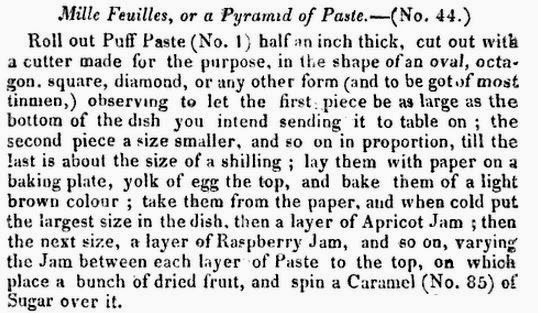 |
| Snapshot of the 1996 Spode Museum's dessert cabinet with services from c1800-c1828 |
 |
| '...a Pyramid of Syllabubs and Jellies' |
This 1820 book is a technical book which records shapes produced by the Spode factory. These are beautifully handpainted onto the pages but not to scale. The book records the name of an item, the sizes in which it was made, its throwing and its turning measurements. Written as a production record, as well as informing about pottery manufacturing techniques of the early 1800s, it also tells us about social history, design history, original names of items, unexpected parts of teasets, multiple sizes of cups and chamber pots, and long-forgotten objects.
And it helps with research into one of my favourites: food history. After all, no food then no pots...? Dessert wares were particularly fine; produced in the most expensive, fashionable styles; and sold to the wealthiest of customers.
Whilst Curator at the Spode Museum, I came across a page in the Spode 1820 Shape Book entitled 'Pyramids with a Sexagon Pedistall Prest to Suit' (sic).
What on earth is one of these?
 |
| The note at the bottom reads '...the 4 lifts at top are thrown together' |
Ever practical, and generous with his knowledge and research, he kindly corrected me that this was not a jelly mould and went on to explain how this item may be used. He also pointed out 'they're huge!' He drew out a paper plan for me derived from measurements in the shape book. The size is nearly 18" high. The details and the plan from this correspondence are in the Spode archive.
Initially even Peter was unsure how the piece was used and, after drawing the life-size paper model, suggested they were for the dessert table perhaps draped with ivy and flowers. Then by chance, whilst he was researching what went in supper sets (again on my behalf) he noticed the following in Dr William Kitchener's The Cook's Oracle (4th Edition London 1822 pg 485): 'Mille Feuilles or a Pyramid of Paste' which has ½" puff paste cut in discs, from plate size down to the 'size of a shilling'. These were then baked (which would raise their thickness to a couple of inches) and mounted one on another with layers of different jams in between to form a pyramid 'of light brown colour'. This is just the same shape as 'Spode's Pyramids with a Sexagon Pedistall Prest to Suit'.
I was able to read more of the description in an 1825 edition and found The Cook's Oracle details continued that on the top you could place a 'bunch of dried fruit' and 'spin a caramel of Sugar over it'. This entry confirms the use of the pyramid for the decoration of a dessert table. Peter pointed out that Kitchener's book was very popular and its publication date of 1822 ideally coincides with Spode's ceramic version in the 1820 Shape Book.
 | ||
|
I have never seen one of these pyramids, or even bits of one. You can only wonder how many were made and, more crucially, do any survive and would they and their component parts even be recognised? Were they left in beautiful, undecorated, very white and translucent Spode bone china; or decorated more elaborately with handpainted designs and gilding?
 |
| From Whiter's book with another centrepiece a 'Beaded Pyramid Stand' on the left |
19th century dessert services from Spode were often spectacular and comprised many, many pieces - sometimes hundreds - made for rich families. The illustration at the top shows dessert services in the Spode Museum collections on display in the late 1990s. Also shown here is a dessert serving dish from about 1825. Every piece in the set would have had a different butterfly and flower centre all hand painted. Another piece from the set, which is in the V & A collections, can be seen by clicking here. Pattern 4485 illustrated below is a design which features fruit and flowers in different variety and combination on every piece of the service.
 |
| Spode serving dish from a large dessert service, Felspar Porcelain, c1825 |
"The next variation which their visit afforded was produced by the entrance of servants with cold meat, cake, and a variety of all the finest fruits in season; but this did not take place till after many a significant look and smile from Mrs. Annesley to Miss Darcy had been given, to remind her of her post. There was now employment for the whole party - for though they could not all talk, they could all eat; and the beautiful pyramids of grapes, nectarines, and peaches soon collected them round the table."
 |
| Dessert plate (note the point of the plate faces the diner) pattern 4485 c1828 |
